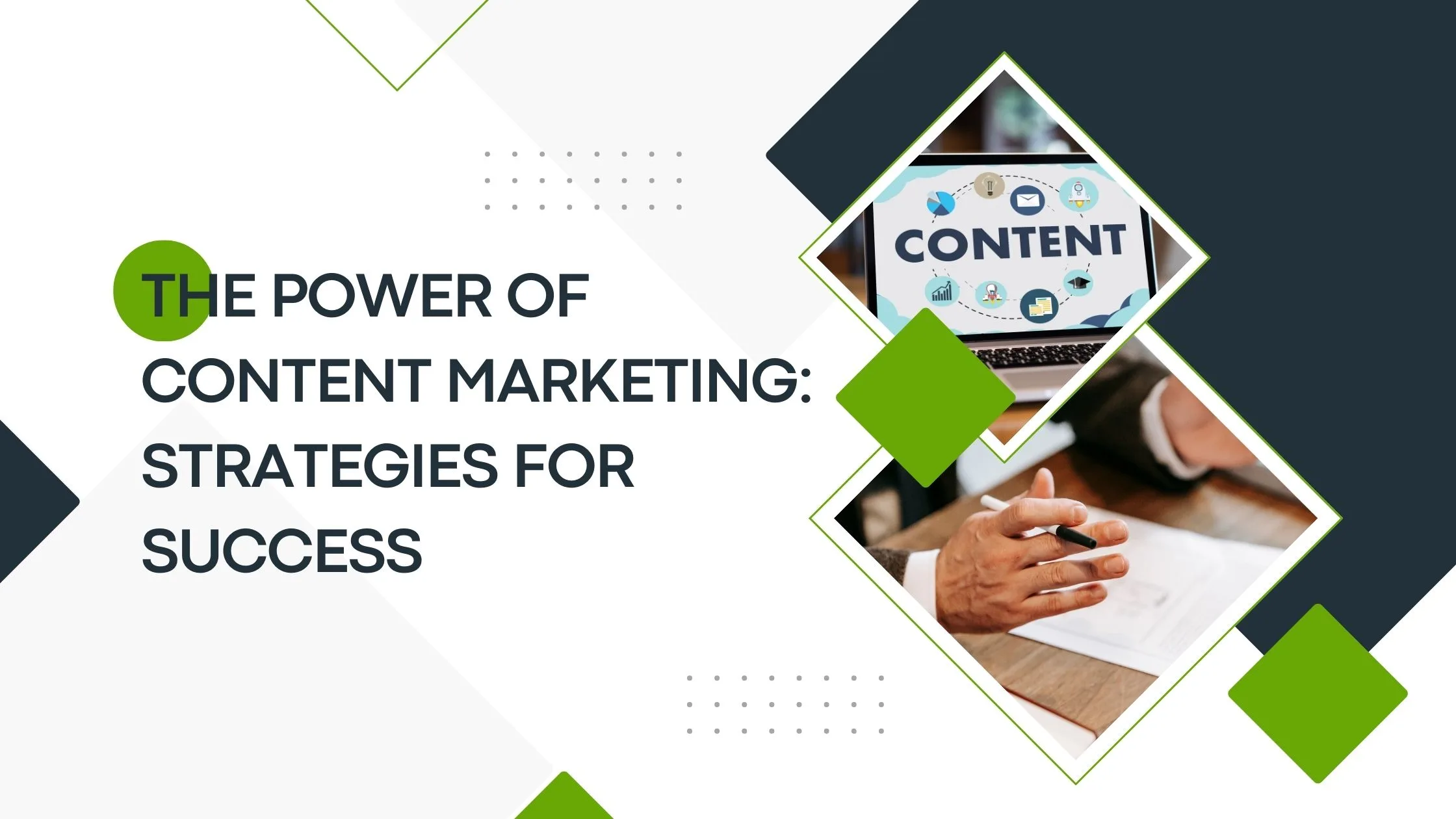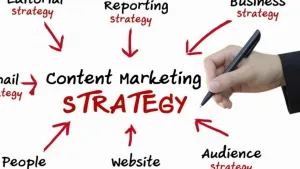The Power of Content Marketing: Strategies for Success
Are you ready to harness the immense power of content marketing and take your business to new heights? Look no further! In this blog post, we will unveil the secrets behind successful content marketing strategies that are guaranteed to captivate your audience and skyrocket your brand’s visibility.
Get ready to unlock a world where compelling storytelling meets strategic promotion, as we explore how content marketing can transform your business into an unstoppable force in today’s digital age. So buckle up, because we’re about to embark on an exhilarating journey towards unparalleled success!
Introduction
Content marketing has become an essential aspect of modern marketing strategies. From small businesses to large corporations, companies are utilizing content to connect with their target audience and drive business success. In today’s digital age, where consumers are bombarded with advertisements and promotions, content marketing offers a unique approach to engage with customers and build long-lasting relationships.
What is Content Marketing?
At its core, content marketing is the creation and sharing of valuable, relevant, and consistent content to attract and retain a clearly defined audience. It involves using various forms of media such as blogs, videos, social media posts, infographics, podcasts, etc., to provide informative or entertaining content that resonates with your target audience. The goal of content marketing is not to explicitly promote a product or service but rather establish credibility and trust with potential customers.
Why is Content Marketing Important?
The power of content marketing lies in its ability to create meaningful connections between brands and consumers. By providing valuable information or entertainment through your content, you can establish yourself as an industry expert and build trust among your target audience. This trust translates into brand loyalty and increased sales in the long run.
Moreover, traditional advertising methods have become less effective due to the rise of ad blockers and consumer skepticism towards traditional ads. On the other hand, quality content that is genuinely helpful or entertaining can break through this noise and capture the attention of potential customers.
– Explanation of what content marketing is
Content marketing is a powerful tool for businesses to attract and engage with their target audience. It involves creating valuable and relevant content that addresses the needs and interests of your target market. This content can take various forms such as blog posts, videos, infographics, social media posts, podcasts, e-books, webinars, and more.
At its core, content marketing is about building trust and credibility with your audience by providing them with valuable information rather than constantly promoting your products or services. It aims to educate and inform rather than sell directly. By consistently delivering high-quality content, businesses can establish themselves as thought leaders in their industry and earn the trust of their potential customers.
One of the key elements of successful content marketing is understanding your target audience. You need to have a clear understanding of who they are, what they care about, where they spend their time online, what kind of content resonates with them, and what motivates them to take action.
Once you have a solid understanding of your target audience, you can create a comprehensive content strategy that aligns with their interests and needs while also supporting your business goals. Your strategy should include defining the types of content you will create (e.g., blog posts vs. videos), the platforms you will use (e.g., website vs. social media), how often you will publish new content, and how you will measure success.
– Importance and benefits of content marketing for businesses
Content marketing has become an essential tool for businesses looking to establish a strong online presence and drive conversions. It involves creating and sharing valuable, relevant, and consistent content to attract and retain a clearly defined target audience. In today’s digital landscape, where consumers are bombarded with advertisements and promotions, content marketing offers a more subtle approach to building brand awareness and credibility.
The importance of content marketing for businesses cannot be overstated. Here are some key benefits that make it an indispensable part of any marketing strategy:
1. Establishes brand authority and credibility: By consistently publishing high-quality content that addresses the pain points of your target audience, you can position yourself as an expert in your industry. This helps build trust with potential customers, making them more likely to choose your products or services over competitors.
2. Boosts search engine rankings: Search engines like Google value fresh, relevant content when ranking websites. By regularly updating your website with valuable blog posts, videos, infographics, etc., you can improve your search engine optimization (SEO) efforts and increase your visibility online.
3. Drives traffic to your website: Quality content attracts visitors to your website who would not have found you otherwise. When people find helpful information on your site that meets their needs, they are more likely to explore other pages on your site and potentially convert into customers.
Identifying Your Target Audience
Before diving into the world of content marketing, it is crucial to first identify your target audience. The success of your content marketing strategy heavily relies on understanding and catering to the needs and preferences of your target audience. By identifying your target audience, you can create content that resonates with them, captures their attention, and ultimately drives conversions.
In this section, we will discuss some key steps to help you identify your target audience:
1. Define Your Product or Service: The first step in identifying your target audience is to clearly define what product or service you are offering. This will help you understand the type of people who would be interested in what you have to offer.
2. Conduct Market Research: Once you have defined your product or service, it’s time to conduct market research. This involves gathering data about your potential customers such as their demographics (age, gender, income), interests, behavior patterns, and purchase habits.
3. Analyze Your Current Customers: Another helpful way to identify your target audience is by analyzing your current customer base. Look at who is already buying from you and try to find common characteristics among them.
4. Create Buyer Personas: A buyer persona is a semi-fictional representation of your ideal customer based on market research and real data about existing customers. It helps put a face and personality behind the demographics and behaviors of your target audience.
– Why knowing your audience is crucial for successful content marketing
Knowing your audience is one of the key elements for successful content marketing. In today’s fast-paced digital world, it is not enough to simply create and distribute content without understanding who your target audience is. With so much noise and clutter on the internet, it is crucial for businesses to tailor their content specifically to their target market in order to stand out and effectively communicate their message.
So why exactly is knowing your audience so important for successful content marketing? Let’s delve into some of the reasons:
1. Targeted messaging: By understanding your audience, you can create more targeted and relevant messaging that resonates with them. This means taking into account factors such as demographics, interests, pain points, and values of your target market. By crafting messages that are specific to their needs and preferences, you are more likely to capture their attention and engage them with your content.
2. Higher conversion rates: When your content speaks directly to your audience’s needs or problems, they are more likely to take action on it. This could mean making a purchase, signing up for a service, or subscribing to your newsletter. By addressing their pain points and offering solutions through your content, you establish trust with your audience which can lead to higher conversion rates.
– Methods for identifying and understanding your target audience
When it comes to content marketing, one of the key factors for success is understanding and effectively targeting your audience. Without a clear understanding of your target audience, your content may not resonate with them and fail to drive engagement or conversions. This is why it is crucial to use methods that can help you identify and understand your target audience.
1. Conduct thorough market research: The first step in identifying and understanding your target audience is conducting thorough market research. This involves gathering data on demographics, interests, behaviors, preferences and pain points of potential customers. Market research can be done through surveys, focus groups, interviews, or by analyzing data from online tools like Google Analytics.
2. Utilize social media analytics: Social media platforms are a goldmine for valuable insights about your target audience. By using analytics tools provided by various social media platforms such as Facebook Insights or Twitter Analytics, you can gain valuable information about your followers such as their age, gender, location, interests and more.
3. Monitor website traffic: Your website visitors can also provide valuable insights into your target audience. Tools like Google Analytics can track the behavior of visitors on your website including pages they visit most frequently, time spent on each page and their journey before leaving the site. This information can help you understand what type of content resonates with them.
Setting Goals and Objectives
In order to have a successful content marketing strategy, it is crucial to set clear and specific goals and objectives. These will serve as the foundation for your entire content marketing plan and guide you towards achieving success.
1. Identify Your Overall Marketing Objectives: The first step in setting goals for your content marketing is to identify your overall marketing objectives. This could include increasing brand awareness, generating leads, driving website traffic, or boosting sales. Having a clear understanding of what you want to achieve through your content will help you create more targeted and effective campaigns.
2. Make Your Goals SMART: Once you have identified your overall objectives, it is important to make them SMART – Specific, Measurable, Achievable, Realistic, and Time-bound. This will give you a clear roadmap for what needs to be done and when it should be accomplished by.
3. Define Your Target Audience: In order for your content marketing efforts to be effective, they need to resonate with your target audience. Take the time to define who your ideal customers are – their age, interests, pain points, etc. This will help you create content that speaks directly to them and encourages engagement.
– Establishing clear goals and objectives for your content marketing strategy
When it comes to content marketing, having a clear set of goals and objectives is crucial for creating an effective strategy. Without a solid understanding of what you want to achieve with your content, it can be difficult to measure success and make necessary adjustments. In this section, we will discuss the importance of establishing clear goals and objectives for your content marketing strategy and how to do so effectively.
1. Define Your Target Audience: The first step in setting up any successful marketing strategy is identifying your target audience. This includes understanding their demographics, interests, pain points, and behaviors. By clearly defining your target audience, you can create content that resonates with them and addresses their specific needs.
2. Identify Your Objectives: Once you have a clear understanding of who you are targeting with your content, it’s time to establish the objectives you want to achieve through your content marketing efforts. These objectives could include increasing brand awareness, driving website traffic or leads, improving customer engagement and retention, or showcasing thought leadership within your industry.
3. Set SMART Goals: A great way to ensure that your goals are realistic and achievable is by following the SMART criteria – Specific, Measurable, Attainable, Relevant and Time-bound. This means setting specific targets such as increasing website traffic by 20% in the next six months or generating 50 new leads per month through content.
– How to measure success and track progress towards your goals
Measuring success and tracking progress towards your goals is a crucial aspect of any content marketing strategy. Without proper tracking, it can be difficult to determine if your efforts are effective or if you need to make adjustments. In this section, we will discuss some key steps for measuring success and tracking progress towards your content marketing goals.
1. Determine Your Key Performance Indicators (KPIs)
The first step in measuring success is to identify the key metrics that will help you track progress towards your goals. These metrics, also known as Key Performance Indicators (KPIs), should align with your overall business objectives and provide insight into the performance of your content marketing efforts.
Some common KPIs for content marketing include website traffic, conversion rates, email subscribers, social media engagement, and lead generation. Depending on your specific goals, you may have different KPIs that are more relevant to your business.
2. Set Realistic Goals
Before you can measure success, you need to establish clear and realistic goals for your content marketing strategy. These goals should be specific, measurable, attainable, relevant and time-bound (SMART).
For example, if one of your main objectives is to increase website traffic through content marketing by 20% in the next six months, this goal meets all the criteria of being SMART. Having well-defined goals will not only help you focus on what matters but also make it easier to track progress towards achieving them.
Creating High-Quality Content
Creating high-quality content is essential for any successful content marketing strategy. In a sea of information and competition, it is crucial to produce content that stands out and engages your target audience. High-quality content not only helps to attract potential customers but also builds trust and credibility with your existing audience.
Here are some key factors to keep in mind when creating high-quality content:
1. Know Your Audience
Before you start creating any type of content, it is important to have a deep understanding of your target audience. This includes knowing their demographics, interests, pain points, and preferred communication channels. By understanding your audience’s needs and preferences, you can tailor your content to effectively resonate with them.
2. Provide Valuable Information
One of the main reasons people consume online content is to gain knowledge or solve a problem. Therefore, it is vital to provide valuable information in your content that addresses the needs or interests of your audience. This could include industry insights, how-to guides, informative articles or case studies.
3. Use Engaging Formats
Content comes in various formats such as text, images, videos, infographics etc., and using different formats can make your content more engaging and appealing to different types of audiences. For instance, visual learners may prefer infographics while others may prefer video tutorials or podcasts.
– Tips for Successful Content Marketing:
1. Know your target audience: Before creating any content, it is important to understand who your target audience is. Conduct market research and create buyer personas to get a better understanding of their needs, preferences, and behaviors. This will help you tailor your content to meet their specific needs.
2. Create high-quality and relevant content: Quality is key when it comes to content marketing. Your content should be informative, engaging, and valuable to your target audience. It should also be relevant to their interests and pain points, in order to capture their attention and keep them engaged.
3. Use different types of content: To appeal to a wider audience and keep them interested, use a variety of content formats such as blog posts, videos, infographics, podcasts, and social media posts. This will not only make your content more visually appealing but also cater to different learning styles.
4. Consistency is key: In order for your content marketing efforts to be successful, consistency is crucial. Develop a consistent posting schedule so that your audience knows when they can expect new content from you.
5. Incorporate SEO best practices: Utilize search engine optimization (SEO) techniques in your blog posts or website pages by including relevant keywords in your headlines, subheadings, and throughout the body of the text. This will make it easier for search engines like Google to find and rank your content.
Conclusion
In today’s digital age, content marketing has become a powerful tool for businesses looking to engage with their target audience and drive conversions. By implementing the strategies discussed in this article, you can effectively create and distribute valuable content that resonates with your audience and drives results.
Remember to stay consistent, track your progress, and adapt as necessary to see continued success in your content marketing efforts. Don’t underestimate the power of quality content – it truly is king in today’s competitive online landscape.





